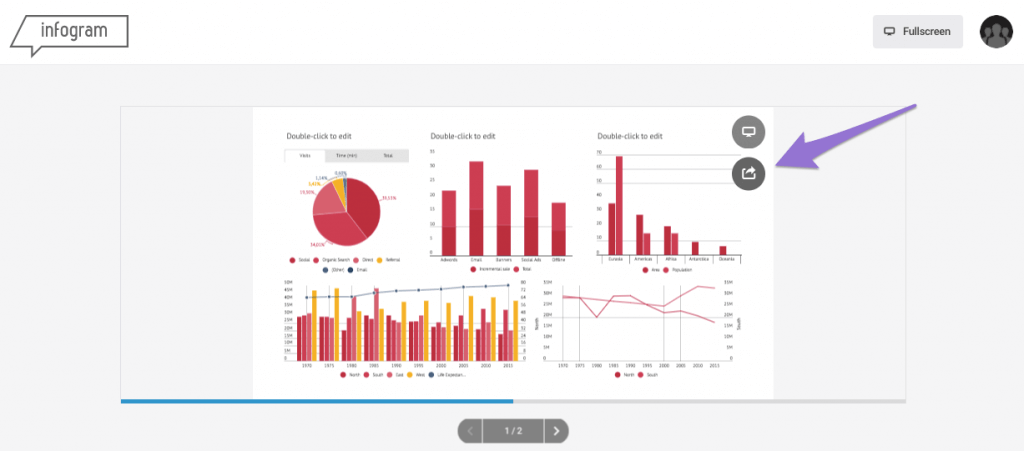09.09.2024 by Infogram
In data analysis, accuracy is one of the most important aspects. And this is exactly what AI can significantly improve. By identifying errors, applying advanced algorithms, and automating tasks, AI promises to achieve more reliable and consistent results. The intersection of artificial intelligence (AI) and data analysis has revolutionized the way businesses and organizations extract valuable insights from their data. AI-powered tools and techniques have become indispensable for automating tasks, spotting patterns, making predictions, and ultimately, driving data-driven decision-making. With all that in mind, in this article, we’ll explore how AI is transforming data analysis and the significant role Infogram plays in visualizing and understanding these insights.

The rise of AI in data analysis
The exponential growth of data in recent years has created a pressing need for efficient and effective data analysis tools. Traditional methods, often manual and time-consuming, have struggled to keep pace with the volume and complexity of modern datasets. AI, with its ability to process vast amounts of data and identify patterns that humans might miss, has emerged as a game-changer in this context.
AI algorithms, such as machine learning and deep learning, can automate repetitive tasks, identify hidden trends, and make accurate predictions. This helps analysts focus on higher-value activities, such as interpreting results and making strategic decisions. Moreover, AI can handle complex data types, including text, images, and audio, which were previously challenging to analyze using traditional methods.
Key applications of AI in data analysis
In recent years, the use of AI has increased and expanded significantly. AI for data analysis now has numerous applications. Let’s explore some key ways AI is being used in data analysis:
- Predictive analytics
AI-powered predictive analytics models can forecast future trends and outcomes based on historical data. This is specifically useful in industries like finance, marketing, and healthcare, where accurate predictions can lead to improved decision-making and risk management. For example, in finance, AI can predict stock market trends, while in healthcare, it can forecast disease outbreaks or patient outcomes.
- Natural Language Processing (NLP)
NLP techniques enable AI to understand and process human language, making it possible to analyze unstructured text data such as customer reviews, social media posts, and news articles. This process can provide valuable insights into public sentiment, brand reputation, and market trends. For example, businesses can use NLP to analyze customer feedback and identify areas for improvement in their products or services.
- Anomaly detection
AI algorithms can identify unusual patterns in data that may indicate fraud, security breaches, or equipment malfunctions. Anomaly detection can ultimately help organizations spot and prevent problems before they escalate. For example, in cybersecurity, AI can detect suspicious network activity that may signal a hacking attempt.
- Recommendation systems
AI-powered recommendation systems can personalize user experiences by suggesting products, services, or content that are likely to be of interest. These systems are widely used in e-commerce, streaming services, and social media platforms. For example, online retailers can use recommendation systems to suggest products that complement a customer’s previous purchases.
- Image and video analysis
Last but definitely not least, AI is valuable in image and video analysis. It can analyze visual data to extract information such as objects, scenes, and emotions. This has applications in fields like medical imaging, autonomous vehicles, and surveillance.
In medical imaging, AI can help in diagnosing diseases by analyzing X-rays, MRIs, and CT scans. However, in autonomous vehicles, AI can process visual data from cameras to navigate safely.
Ultimately, AI offers a wide range of applications in data analysis. From predicting stock market trends, diagnosing diseases and signaling a hacking attempt to recommending relevant products and services. All of these applications have the potential to drive innovation, improve decision-making, and solve complex problems across various industries. Furthermore, AI technology is still advancing, so we can surely expect to see even more groundbreaking applications in the future.
The power of Infogram in data visualization
While AI provides the foundation for data analysis, Infogram offers a powerful tool for visualizing and understanding the insights derived from the data. With Infogram’s user-friendly interface, interactive features, and inspirational library of templates, it enables analysts to create visually appealing and informative charts, graphs, and dashboards. Let’s take a deeper look at how you can turn complex data into easily navigable visualizations.
Empowering data analysis with data visualizations
Infogram is a versatile data visualization tool that can significantly affect the impact of AI-powered data analysis. By transforming raw data into visually appealing and informative charts, graphs, and dashboards, Infogram helps you to:
Communicate insights effectively
Infogram’s data visualizations make complex data more accessible and understandable. By transforming raw data into visually appealing charts, graphs, and dashboards, Infogram helps you communicate insights clearly and effectively to your audience, regardless of their technical expertise.
Identify trends and patterns
Visual representations can reveal trends and patterns that might be difficult to spot in raw data. Infogram’s interactive tools allow you to explore your data visually, identifying relationships, correlations, and outliers that can inform your analysis and decision-making.
Tell compelling stories
Everyone loves stories. Infogram empowers you to create compelling stories around your data, making it more engaging and memorable. By combining visualizations with descriptive text and storytelling techniques, you can transform your data into compelling narratives that resonate with your audience.
Integrate with AI tools
Infogram can be used in conjunction with AI tools to automate data preparation and visualization tasks, saving time and effort. For example, you can use AI to clean and preprocess your data, and then use Infogram to create visualizations based on the results. This integration can streamline your workflow and enhance the efficiency of your data analysis process.
Plus, Infogram also offers AI-powered functionalities that can help you create infographics in seconds or assist you in choosing the best type of chart for your data set.
Key features of Infogram
Now, let’s take a look at key Infogram features that helps you transform your data.
Wide range of visualization types
Infogram offers a wide range of chart types to suit different data analysis needs. Whether you want to compare categories, track trends over time, or visualize geographic data, Infogram has the right chart or map for you. For example, you can use bar charts to compare sales figures across different regions, line charts to track stock prices over time, and interactive maps to visualize geographic data such as population density or customer distribution.
Explore this dashboard with diverse charts and an interactive map:
Customization options
Infogram provides a range of customization options, allowing you to tailor your visualizations to match your branding and preferences. You can customize the colors, fonts, and layouts of your visualizations to ensure that they align with your organization’s style and messaging. This customization helps to create visually appealing and professional-looking data presentations.
Note: If you have a Business, Team, or Enterprise plan, you can access advanced branding features. This includes swapping Infogram’s logo with your own and creating a brand kit with your colors, fonts, and more.
Interactive elements
Infogram allows users to add interactive elements to their visualizations, making them more engaging and informative. For example, you can add tooltips to provide additional context for data points, filters to allow users to explore different subsets of data, and drill-down capabilities to explore data at a more granular level. These interactive elements enhance the user experience and make it easier to uncover insights hidden within your data.
Explore the interactive elements in this engaging infographic:
Collaboration features
Infogram supports collaboration among team members, making it easy to share and work on visualizations together. If you have Infogram’s Team or Enterprise plan, you can create shared projects, invite team members to collaborate on visualizations, and track changes and comments. Thes collaboration functionalities promote teamwork and ensure that everyone is on the same page when it comes to data analysis and communication.
Discover more features by visiting Infogram!
How Infogram can help in data analysis
The aforementioned features can significantly impact and help your data analysis processes. Here are a few key ways Infogram can assist:
Visualize AI-generated insights
Infogram can be used to create interactive dashboards that display AI-generated insights in real-time, allowing you to monitor and analyze model performance. By visualizing AI-generated data, you can identify unexpected trends or anomalies that may require further investigation. Plus, Infogram’s customization options allow you to tailor visualizations to specific needs and preferences, ensuring that insights are presented in a clear and effective manner.
Explore data patterns
Infogram’s data exploration tools can help you uncover hidden patterns and relationships within AI-generated datasets. By creating visualizations such as scatter plots and heatmaps, you can easily identify correlations between variables and gain a deeper understanding of the underlying data. Furthermore, Infogram’s interactive features also allow you to drill down into specific data points and explore them in more detail.
Communicate AI findings
Infogram can be used to create visually appealing and informative presentations that effectively convey the results of AI projects. By using charts, graphs, and other visualizations, you can present complex AI concepts in a way that’s easy to understand for both technical and non-technical audiences. Also, Infogram’s sharing options can help you easily distribute AI findings to stakeholders and collaborators.

In conclusion, Infogram is a valuable tool for data analysis, particularly when combined with AI. By providing powerful visualization capabilities and seamless integration with AI tools, Infogram can help businesses and organizations extract maximum value from their data and make highly informed decisions.
The future of AI and data analysis
The integration of AI in data analysis is a rapidly evolving field with immense potential. As AI technologies continue to advance, we can expect to see even more innovative applications and benefits. Some of the emerging trends include:
Explainable AI
Developing AI models that can provide transparent explanations for their decisions, making them more trustworthy and accountable. This is particularly important in industries where decisions have significant consequences, such as healthcare and finance.
Generative AI
Generative AI models can create new data, such as images, text, or music, based on patterns learned from existing data. This has applications in fields like content creation, medicine discovery, and materials science.
Edge AI
Edge AI involves deploying AI models at the edge of the network, closer to the data source. This can reduce latency, improve privacy, and enable real-time decision-making in applications like autonomous vehicles, IoT devices, and industrial automation.
AI-powered automation
Automating end-to-end data analysis workflows, from data collection and cleaning to insight generation and visualization. This can significantly improve efficiency and reduce the need for manual intervention.
Ethical AI
An ethical AI development could address the ethical implications of AI for data analysis, such as bias, privacy, and transparency. Ensuring that AI is used responsibly and equitably is crucial for building trust and avoiding negative consequences.

Conclusion
AI has become an indispensable tool for data analysis, enabling organizations to automate tasks, spot patterns, make predictions, and extract valuable insights from their data. Infogram, with its powerful visualization capabilities, complements AI by providing a means to effectively communicate these insights to stakeholders. By embracing AI and leveraging tools like Infogram, you can unlock the full potential of your data and drive data-driven decision-making.
Explore Infogram and everything it can offer to your and your organization. Try Infogram today!
Get data visualization tips every week:
New features, special offers, and exciting news about the world of data visualization.